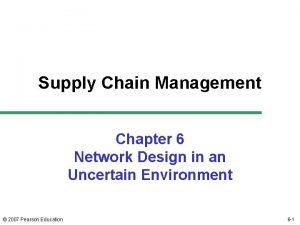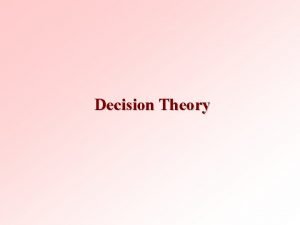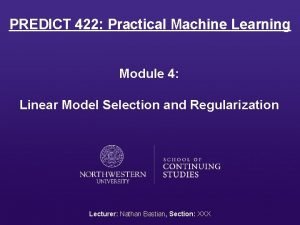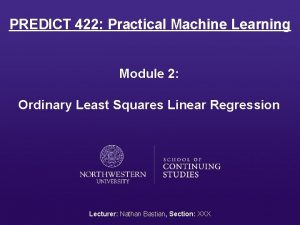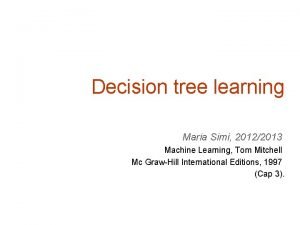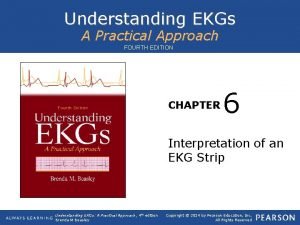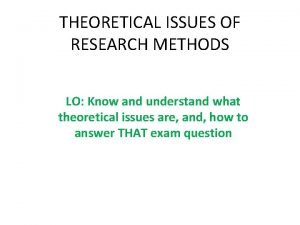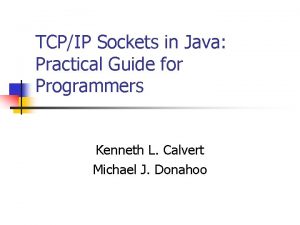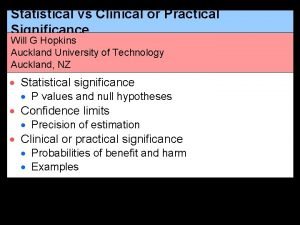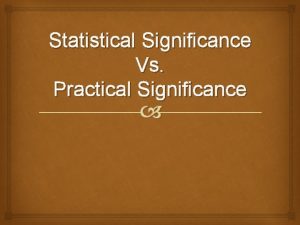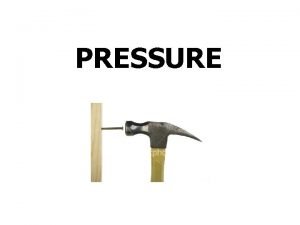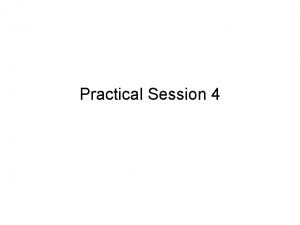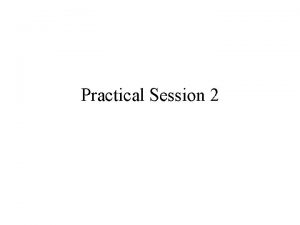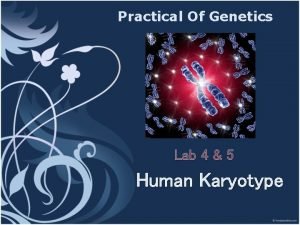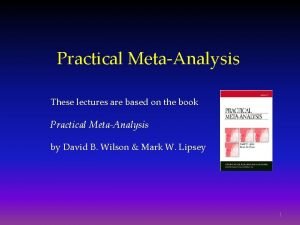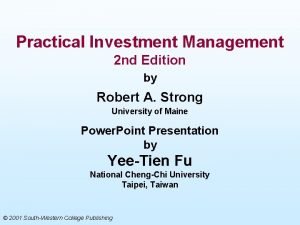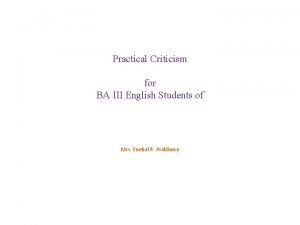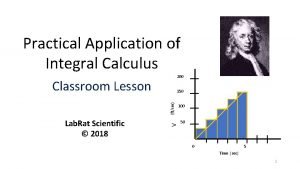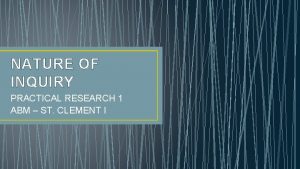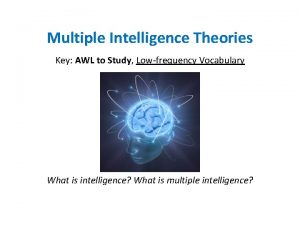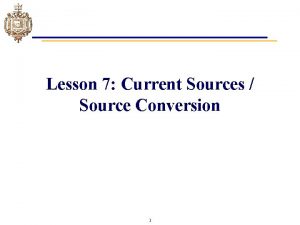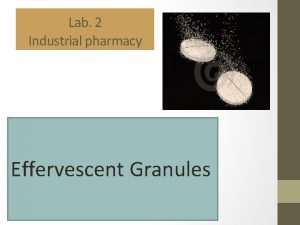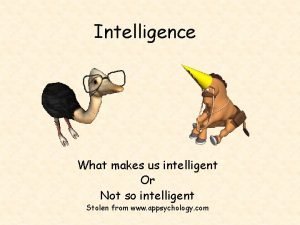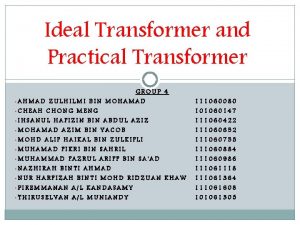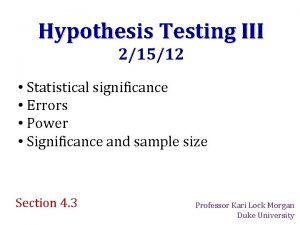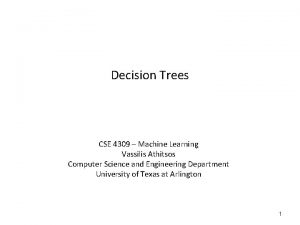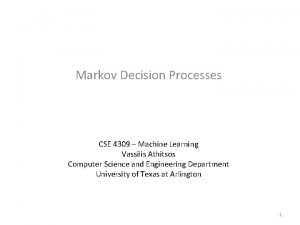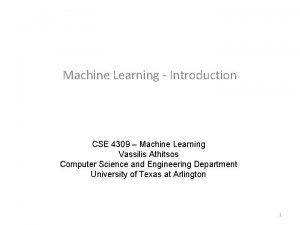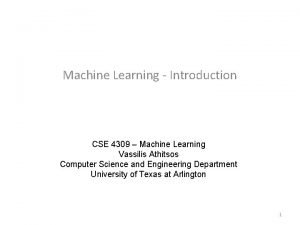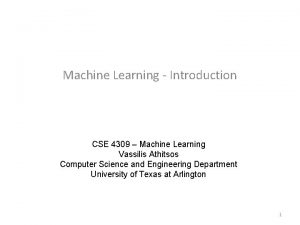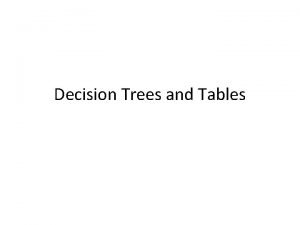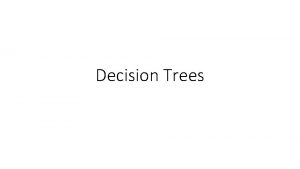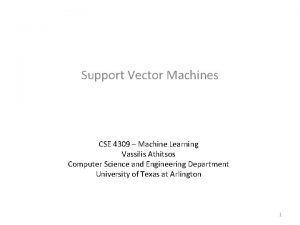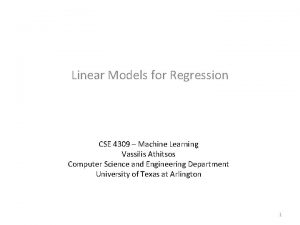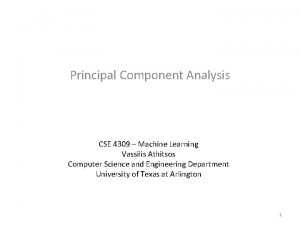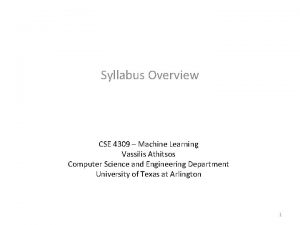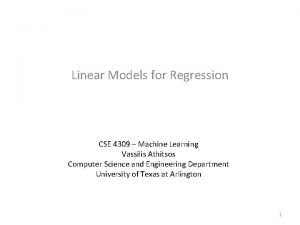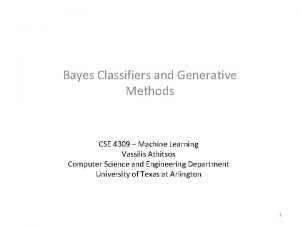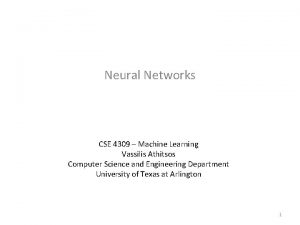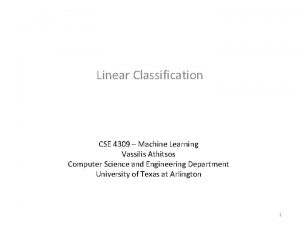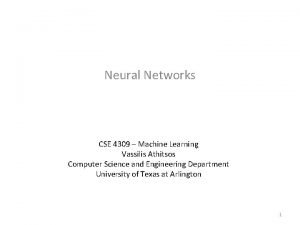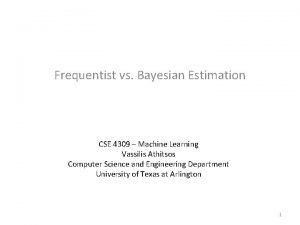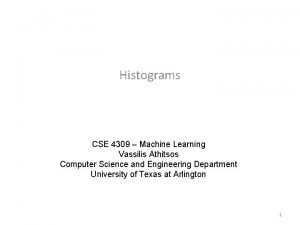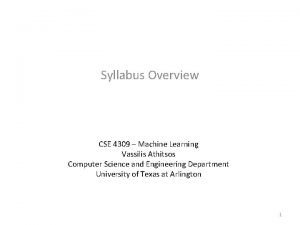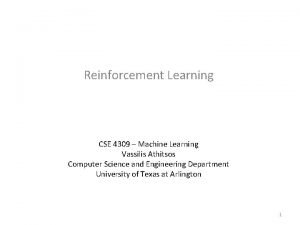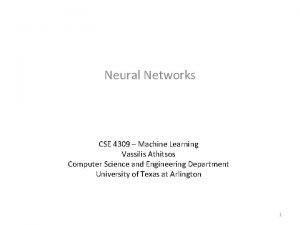Practical Issues with Decision Trees CSE 4309 Machine





















































- Slides: 53

Practical Issues with Decision Trees CSE 4309 – Machine Learning Vassilis Athitsos Computer Science and Engineering Department University of Texas at Arlington 1

Programming Assignment • The next programming assignment asks you to implement decision trees, as well as a variation called “decision forests”. • There are several concepts that you will need to implement, that we have not addressed yet. • These concepts are discussed in these slides. 2

Data • The dataset format is the same as in several previous assignments. • For each dataset, you are given: – a training file, that you use to learn decision trees. – a test file, that you use to apply decision trees and measure their accuracy. • All three datasets follow the same format: – Each line is an object. – Each column is an attribute, except: – The last column is the class label. 3

Data • Values are separated by whitespace. • The attribute values are real numbers (doubles). – They are integers in some datasets, just treat those as doubles. • The class labels are integers. 4

Class Labels Are Not Attributes • A classic mistake is to forget that the last column contains class labels. • What happens if you include the last column in your attributes? 5

Class Labels Are Not Attributes • A classic mistake is to forget that the last column contains class labels. • What happens if you include the last column in your attributes? • You get perfect classification accuracy. • The decision tree will be using class labels to predict class labels. – Not very hard to do. • So, make sure that, when you load the data, you separate the last column from the rest of the columns. 6

Dealing with Continuous Values • Our previous discussion on decision trees assumed that each attribute takes a few discrete values. • Instead, in these datasets the attributes take continuous values. • There are several ways to discretize continuous values. • For the assignment, we will discretize using thresholds. – The test that you will be choosing for each node will be specified using both an attribute and a threshold. – Objects whose value at that attribute is LESS THAN the threshold go to the left child. – Objects whose value at that attribute is GREATER THAN OR EQUAL TO the threshold go to the right child. 7

Dealing with Continuous Values • For example: supposed that the test that is chosen for a node N uses attribute 5 and a threshold 30. 7. • Then: – Objects whose value at attribute 5 is LESS THAN 30. 7 go to the left child of N. – Objects whose value at attribute 5 is GREATER THAN OR EQUAL TO 30. 7 go to the right child. • Please stick to these specs. • Do not use LESS THAN OR EQUAL instead of LESS THAN. 8

Dealing with Continuous Values • Using thresholds as described, what is the maximum number of children for a node? 9

Dealing with Continuous Values • Using thresholds as described, what is the maximum number of children for a node? • Two. Your decision trees will be binary. 10

Choosing a Threshold • How can you choose a threshold? – What makes a threshold better than another threshold? • Remember, once you have chosen a threshold, you get a binary version of your attribute. – Essentially, you get an attribute with two discrete values. • You know all you need to know to compute the information gain of this binary attribute. • Given an attribute A, different thresholds applied to A produce different values for information gain. • The best threshold is which one? 11

Choosing a Threshold • How can you choose a threshold? – What makes a threshold better than another threshold? • Remember, once you have chosen a threshold, you get a binary version of your attribute. – Essentially, you get an attribute with two discrete values. • You know all you need to know to compute the information gain of this binary attribute. • Given an attribute A, different thresholds applied to A produce different values for information gain. • The best threshold is which one? – The one leading to the highest information gain. 12

Searching Thresholds • Given a node N, and given an attribute A with continuous values, you should check various thresholds, to see which one gives you the highest information gain for attribute A at node N. • How many thresholds should you try? • There are (again) many different approaches. • For the assignment, you should try 50 thresholds, chosen as follows: – Let L be the smallest value of attribute A among the training objects at node N. – Let M be the largest value of attribute A among the training objects at node N. – Then, try thresholds: L + (M-L)/51, L + 2*(M-L)/51, …, L + 50*(M-L)/51. – Overall, you try all thresholds of the form L + K*(M-L)/51, for K = 1, …, 50. 13

Review: Decision Tree Learning function DTL_Top. Level(examples) returns a decision tree attributes = list of all attributes in the examples default = DISTRIBUTION(examples) return DTL(examples, attributes, default) • DTL_Top. Level is the top level function for decision tree learning. • It defines two variables (attributes and default), and calls the DTL function. – DTL (explained in the next slides) is an auxiliary function that does the actual work. • DTL is recursive, so the job of DTL_Top. Level is to just make the first call to DTL, with the right arguments. 14

Review: Decision Tree Learning function DTL(examples, attributes, default) returns a decision tree if examples is empty then return default else if all examples have the same class then return the class else (best_attribute, best_threshold) = CHOOSE-ATTRIBUTE(examples, attributes) tree = a new decision tree with root test (best_attribute, best_threshold) examples_left = {elements of examples with best_attribute < threshold} examples_right = {elements of examples with best_attribute >= threshold} tree. left_child = DTL(examples_left, attributes, DISTRIBUTION(examples)) tree. right_child = DTL(examples_right, attributes, DISTRIBUTION(examples)) return tree • Above you see the DTL function that we have reviewed previously, with a few modifications, to account for the assignment requirements: 15

Review: Decision Tree Learning function DTL(examples, attributes, default) returns a decision tree if examples is empty then return default else if all examples have the same class then return the class else (best_attribute, best_threshold) = CHOOSE-ATTRIBUTE(examples, attributes) tree = a new decision tree with root test (best_attribute, best_threshold) examples_left = {elements of examples with best_attribute < threshold} examples_right = {elements of examples with best_attribute >= threshold} tree. left_child = DTL(examples_left, attributes, DISTRIBUTION(examples)) tree. right_child = DTL(examples_right, attributes, DISTRIBUTION(examples)) return tree • Above you see the DTL function that we have reviewed previously, with a few modifications, to account for the assignment requirements: – CHOOSE-ATTRIBUTE needs to pick both an attribute and a threshold. 16

Review: Decision Tree Learning function DTL(examples, attributes, default) returns a decision tree if examples is empty then return default else if all examples have the same class then return the class else (best_attribute, best_threshold) = CHOOSE-ATTRIBUTE(examples, attributes) tree = a new decision tree with root test (best_attribute, best_threshold) examples_left = {elements of examples with best_attribute < threshold} examples_right = {elements of examples with best_attribute >= threshold} tree. left_child = DTL(examples_left, attributes, DISTRIBUTION(examples)) tree. right_child = DTL(examples_right, attributes, DISTRIBUTION(examples)) return tree • How are these DTL recursive calls different than before? 17

Review: Decision Tree Learning function DTL(examples, attributes, default) returns a decision tree if examples is empty then return default else if all examples have the same class then return the class else (best_attribute, best_threshold) = CHOOSE-ATTRIBUTE(examples, attributes) tree = a new decision tree with root test (best_attribute, best_threshold) examples_left = {elements of examples with best_attribute < threshold} examples_right = {elements of examples with best_attribute >= threshold} tree. left_child = DTL(examples_left, attributes, DISTRIBUTION(examples)) tree. right_child = DTL(examples_right, attributes, DISTRIBUTION(examples)) return tree • How are these DTL recursive calls different than before? – Before, we were passing attributes – best_attribute. – Now we are passing attributes, without removing best_attribute. – Why? 18

Review: Decision Tree Learning function DTL(examples, attributes, default) returns a decision tree if examples is empty then return default else if all examples have the same class then return the class else (best_attribute, best_threshold) = CHOOSE-ATTRIBUTE(examples, attributes) tree = a new decision tree with root test (best_attribute, best_threshold) examples_left = {elements of examples with best_attribute < threshold} examples_right = {elements of examples with best_attribute >= threshold} tree. left_child = DTL(examples_left, attributes, DISTRIBUTION(examples)) tree. right_child = DTL(examples_right, attributes, DISTRIBUTION(examples)) return tree • How are these DTL recursive calls different than before? – Before, we were passing attributes – best_attribute. – Now we are passing attributes, without removing best_attribute. – The best attribute may still be useful later, with a different threshold. 19

Using an Attribute Twice in a Path Patrons? None Full Some Raining? Yes No Patrons? None Some Full • When we were using attributes with a few discrete values, it was useless to have the same attribute appear twice in a path from the root. – The second time, the information gain is 0, because all training examples go to the same child. 20

Using an Attribute Twice in a Path attribute = 4, threshold = 0. 7 < thr >= thr attribute = 4, threshold = 0. 9 < thr >= thr • When we use attributes with continuous values, together with a threshold, it may be useful to have the same attribute appear twice in a path from the root. – The second time, the information gain does not have to be 0, because we are using a different threshold. – The second time, all our training examples have values >= 0. 7 for attribute 4. – Some of those values may be < 0. 9, some may be >= 0. 9. 21

Review: Decision Tree Learning function DTL(examples, attributes, default) returns a decision tree if examples is empty then return default else if all examples have the same class then return the class else (best_attribute, best_threshold) = CHOOSE-ATTRIBUTE(examples, attributes) tree = a new decision tree with root test (best_attribute, best_threshold) examples_left = {elements of examples with best_attribute < threshold} examples_right = {elements of examples with best_attribute >= threshold} tree. left_child = DTL(examples_left, attributes, DISTRIBUTION(examples)) tree. right_child = DTL(examples_right, attributes, DISTRIBUTION(examples)) return tree • How are these DTL recursive calls different than before? – There is one more difference, in addition to not removing best_attribute from attributes. 22

Review: Decision Tree Learning function DTL(examples, attributes, default) returns a decision tree if examples is empty then return default else if all examples have the same class then return the class else (best_attribute, best_threshold) = CHOOSE-ATTRIBUTE(examples, attributes) tree = a new decision tree with root test (best_attribute, best_threshold) examples_left = {elements of examples with best_attribute < threshold} examples_right = {elements of examples with best_attribute >= threshold} tree. left_child = DTL(examples_left, attributes, DISTRIBUTION(examples)) tree. right_child = DTL(examples_right, attributes, DISTRIBUTION(examples)) return tree • How are these DTL recursive calls different than before? – Instead of calling MODE(examples), we call DISTRIBUTION(examples). – More details on that later in these slides, when we discuss decision forests. 23

Search for Best Test function DTL(examples, attributes, default) returns a decision tree if examples is empty then return default else if all examples have the same class then return the class else (best_attribute, best_threshold) = CHOOSE-ATTRIBUTE(examples, attributes) tree = a new decision tree with root test (best_attribute, best_threshold) examples_left = {elements of examples with best_attribute < threshold} examples_right = {elements of examples with best_attribute >= threshold} tree. left_child = DTL(examples_left, attributes, DISTRIBUTION(examples)) tree. right_child = DTL(examples_right, attributes, DISTRIBUTION(examples)) return tree • In this code, where do we search for the combination of attribute and threshold that give the highest information gain? 24

Search for Best Test function DTL(examples, attributes, default) returns a decision tree if examples is empty then return default else if all examples have the same class then return the class else (best_attribute, best_threshold) = CHOOSE-ATTRIBUTE(examples, attributes) tree = a new decision tree with root test (best_attribute, best_threshold) examples_left = {elements of examples with best_attribute < threshold} examples_right = {elements of examples with best_attribute >= threshold} tree. left_child = DTL(examples_left, attributes, DISTRIBUTION(examples)) tree. right_child = DTL(examples_right, attributes, DISTRIBUTION(examples)) return tree • The search for the best combination of attribute and threshold happens in the CHOOSE-ATTRIBUTE function. 25

CHOOSE-ATTRIBUTE, Optimized function CHOOSE-ATTRIBUTE(examples, attributes) returns (attribute, threshold) max_gain = best_attribute = best_threshold = -1 for each attribute A of attributes do attribute_values = SELECT-COLUMN(examples, A) L = min(attribute_values) M = max(attribute_values) for K = 1; K <= 50; K++ threshold = L + K*(M-L)/51 gain = INFORMATION-GAIN(examples, A, threshold) if gain > max_gain then max_gain = gain best_attribute = A best_threshold = threshold return (best_attribute, best_threshold) • Note: in the assignment, use this CHOOSE-ATTRIBUTE version when the “optimized” option is provided on the command line. More details in a bit. 26

CHOOSE-ATTRIBUTE, Optimized function CHOOSE-ATTRIBUTE(examples, attributes) returns (attribute, threshold) max_gain = best_attribute = best_threshold = -1 for each attribute A of attributes do attribute_values = SELECT-COLUMN(examples, A) L = min(attribute_values) M = max(attribute_values) for K = 1; K <= 50; K++ threshold = L + K*(M-L)/51 gain = INFORMATION-GAIN(examples, A, threshold) if gain > max_gain then max_gain = gain best_attribute = A best_threshold = threshold return (best_attribute, best_threshold) • examples is the training data. It is a matrix, where each row is a training object, each column is an attribute, the last column contains class labels. 27

CHOOSE-ATTRIBUTE, Optimized function CHOOSE-ATTRIBUTE(examples, attributes) returns (attribute, threshold) max_gain = best_attribute = best_threshold = -1 for each attribute A of attributes do attribute_values = SELECT-COLUMN(examples, A) L = min(attribute_values) M = max(attribute_values) for K = 1; K <= 50; K++ threshold = L + K*(M-L)/51 gain = INFORMATION-GAIN(examples, A, threshold) if gain > max_gain then max_gain = gain best_attribute = A best_threshold = threshold return (best_attribute, best_threshold) • To fit with this pseudocode, attributes can simply be an array, containing values 0, 1, …, up to the number of attributes – 1. 28

CHOOSE-ATTRIBUTE, Optimized function CHOOSE-ATTRIBUTE(examples, attributes) returns (attribute, threshold) max_gain = best_attribute = best_threshold = -1 for each attribute A of attributes do attribute_values = SELECT-COLUMN(examples, A) L = min(attribute_values) M = max(attribute_values) for K = 1; K <= 50; K++ threshold = L + K*(M-L)/51 gain = INFORMATION-GAIN(examples, A, threshold) if gain > max_gain then max_gain = gain best_attribute = A best_threshold = threshold return (best_attribute, best_threshold) • The function returns the combination of attribute and threshold that produce the highest information gain. 29

CHOOSE-ATTRIBUTE, Optimized function CHOOSE-ATTRIBUTE(examples, attributes) returns (attribute, threshold) max_gain = best_attribute = best_threshold = -1 for each attribute A of attributes do attribute_values = SELECT-COLUMN(examples, A) L = min(attribute_values) M = max(attribute_values) for K = 1; K <= 50; K++ threshold = L + K*(M-L)/51 gain = INFORMATION-GAIN(examples, A, threshold) if gain > max_gain then max_gain = gain best_attribute = A best_threshold = threshold return (best_attribute, best_threshold) • These variables will keep track of the attribute and threshold that have produced the highest information gain so far. 30

CHOOSE-ATTRIBUTE, Optimized function CHOOSE-ATTRIBUTE(examples, attributes) returns (attribute, threshold) max_gain = best_attribute = best_threshold = -1 for each attribute A of attributes do attribute_values = SELECT-COLUMN(examples, A) L = min(attribute_values) M = max(attribute_values) for K = 1; K <= 50; K++ threshold = L + K*(M-L)/51 gain = INFORMATION-GAIN(examples, A, threshold) if gain > max_gain then max_gain = gain best_attribute = A best_threshold = threshold return (best_attribute, best_threshold) • Obviously, to find the best attribute, we must loop over all attributes. 31

CHOOSE-ATTRIBUTE, Optimized function CHOOSE-ATTRIBUTE(examples, attributes) returns (attribute, threshold) max_gain = best_attribute = best_threshold = -1 for each attribute A of attributes do attribute_values = SELECT-COLUMN(examples, A) L = min(attribute_values) M = max(attribute_values) for K = 1; K <= 50; K++ threshold = L + K*(M-L)/51 gain = INFORMATION-GAIN(examples, A, threshold) if gain > max_gain then max_gain = gain best_attribute = A best_threshold = threshold return (best_attribute, best_threshold) • attribute _values is the array containing the values of all examples for attribute A. 32

CHOOSE-ATTRIBUTE, Optimized function CHOOSE-ATTRIBUTE(examples, attributes) returns (attribute, threshold) max_gain = best_attribute = best_threshold = -1 for each attribute A of attributes do attribute_values = SELECT-COLUMN(examples, A) L = min(attribute_values) M = max(attribute_values) for K = 1; K <= 50; K++ threshold = L + K*(M-L)/51 gain = INFORMATION-GAIN(examples, A, threshold) if gain > max_gain then max_gain = gain best_attribute = A best_threshold = threshold return (best_attribute, best_threshold) • We find the minimum and maximum value of attribute A among the examples, so that we can try 50 threshold values between the min and max. 33

CHOOSE-ATTRIBUTE, Optimized function CHOOSE-ATTRIBUTE(examples, attributes) returns (attribute, threshold) max_gain = best_attribute = best_threshold = -1 for each attribute A of attributes do attribute_values = SELECT-COLUMN(examples, A) L = min(attribute_values) M = max(attribute_values) for K = 1; K <= 50; K++ threshold = L + K*(M-L)/51 gain = INFORMATION-GAIN(examples, A, threshold) if gain > max_gain then max_gain = gain best_attribute = A best_threshold = threshold return (best_attribute, best_threshold) • Loop over the 50 thresholds. 34

CHOOSE-ATTRIBUTE, Optimized function CHOOSE-ATTRIBUTE(examples, attributes) returns (attribute, threshold) max_gain = best_attribute = best_threshold = -1 for each attribute A of attributes do attribute_values = SELECT-COLUMN(examples, A) L = min(attribute_values) M = max(attribute_values) for K = 1; K <= 50; K++ threshold = L + K*(M-L)/51 gain = INFORMATION-GAIN(examples, A, threshold) if gain > max_gain then max_gain = gain best_attribute = A best_threshold = threshold return (best_attribute, best_threshold) • For each threshold, measure the information gain attained on these examples using that combination of attribute A and threshold. 35

CHOOSE-ATTRIBUTE, Optimized function CHOOSE-ATTRIBUTE(examples, attributes) returns (attribute, threshold) max_gain = best_attribute = best_threshold = -1 for each attribute A of attributes do attribute_values = SELECT-COLUMN(examples, A) L = min(attribute_values) M = max(attribute_values) for K = 1; K <= 50; K++ threshold = L + K*(M-L)/51 gain = INFORMATION-GAIN(examples, A, threshold) if gain > max_gain then max_gain = gain best_attribute = A best_threshold = threshold return (best_attribute, best_threshold) • If we found the best combination of attribute and threshold so far, keep track of it. 36

CHOOSE-ATTRIBUTE, Optimized function CHOOSE-ATTRIBUTE(examples, attributes) returns (attribute, threshold) max_gain = best_attribute = best_threshold = -1 for each attribute A of attributes do attribute_values = SELECT-COLUMN(examples, A) L = min(attribute_values) M = max(attribute_values) for K = 1; K <= 50; K++ threshold = L + K*(M-L)/51 gain = INFORMATION-GAIN(examples, A, threshold) if gain > max_gain then max_gain = gain best_attribute = A best_threshold = threshold return (best_attribute, best_threshold) • Return the best combination of attribute and threshold that we have found. 37

Using Many Different Tests • When we have continuous-valued attributes, the number of possible tests (combinations of attribute and threshold) can be huge. • There also many applications where the number of attributes is itself huge (thousands, or millions). • Can a single decision tree apply millions of tests to an object? • In theory yes, but to learn such a tree, we would need a humongous amount of training data, more than we can handle with today’s computers. 38

Decision Forests • When we have too many combinations of attributes and thresholds to fit into a single tree, we can learn multiple different trees. • Question: how do we learn multiple different trees? – Will our DTL algorithm work? • No. The version we have seen is deterministic. • Given the same training examples, it will always come up with the same tree. – Unless there are ties, where multiple combinations of attributes and thresholds tie for best, and we let DTL choose randomly among them. 39

Decision Forests • To learn multiple different trees, we need to force the algorithm to make some random choices, so that each time it is called it produces a different tree. • There are different approaches as to what to randomize. • We will follow a simple approach: – CHOOSE-ATTRIBUTE chooses an attribute randomly. – For that attribute that is chosen randomly, we still need to find the best threshold. 40

CHOOSE-ATTRIBUTE, Randomized function CHOOSE-ATTRIBUTE(examples, attributes) returns (attribute, threshold) max_gain = best_threshold = -1 A = RANDOM-ELEMENT(attributes) attribute_values = SELECT-COLUMN(examples, A) L = min(attribute_values) M = max(attribute_values) for K = 1; K <= 50; K++ threshold = L + K*(M-L)/51 gain = INFORMATION-GAIN(examples, A, threshold) if gain > max_gain then max_gain = gain best_threshold = threshold return (A, best_threshold) • Here is the randomized version of CHOOSE-ATTRIBUTE. • Main modification: Now we pick a random attribute. 41

CHOOSE-ATTRIBUTE, Randomized function CHOOSE-ATTRIBUTE(examples, attributes) returns (attribute, threshold) max_gain = best_threshold = -1 A = RANDOM-ELEMENT(attributes) attribute_values = SELECT-COLUMN(examples, A) L = min(attribute_values) M = max(attribute_values) for K = 1; K <= 50; K++ threshold = L + K*(M-L)/51 gain = INFORMATION-GAIN(examples, A, threshold) if gain > max_gain then max_gain = gain best_threshold = threshold return (A, best_threshold) • We still search to find the best threshold for that attribute, so as to maximize information gain. 42

Choosing CHOOSE-ATTRIBUTE Version • • So, we have now two different CHOOSE-ATTRIBUTE versions. Question: which one do you use in the assignment? Answer: both. The third command line argument determines which version you use. • The third command line argument can have four possible values: – optimized - use the first CHOOSE-ATTRIBUTE version, that finds the best combination of attribute and threshold, learn a single tree. – randomized - use the second CHOOSE-ATTRIBUTE version, learn a single randomized tree. – forest 3 - use the second CHOOSE-ATTRIBUTE version, learn three randomized trees. – forest 15 - use the second CHOOSE-ATTRIBUTE version, learn fifteen randomized trees. 43

Classification with Random Forests • When we apply multiple decision trees to the same object, obviously the trees may provide different answers. • How can we combine those answers into a single best answer? • Solution: the answer of each tree will be a probability distribution, assigning a probability to each class. • To classify an object using a decision forest, consisting of multiple decision trees: – First, apply each tree to the object, to obtain from that tree a probability distribution. – Then, compute the average of those probability distributions. For each class, simply compute the average of its probabilities. – Finally, identify and output the class with the highest average probability. 44

Storing Probability Distributions function DTL(examples, attributes, default) returns a decision tree if examples is empty then return default else if all examples have the same class then return the class else (best_attribute, best_threshold) = CHOOSE-ATTRIBUTE(examples, attributes) tree = a new decision tree with root test (best_attribute, best_threshold) examples_left = {elements of examples with best_attribute < threshold} examples_right = {elements of examples with best_attribute >= threshold} tree. left_child = DTL(examples_left, attributes, DISTRIBUTION(examples)) tree. right_child = DTL(examples_right, attributes, DISTRIBUTION(examples)) return tree • This is why we have replaced the MODE function with a DISTRIBUTION function. • Suppose you have N classes, and your class labels are from 0 to N-1. • Then, the DISTRIBUTION function simply returns an array, whose i-th position is the probability of the i-th class. 45

Example • Suppose we have five classes. • Suppose that we are at a node in the decision tree where: – – – 35 training examples are from class 0. 22 training examples are from class 1. 15 training examples are from class 2. 37 training examples are from class 3. 12 training examples are from class 4. • What does DISTRIBUTION(examples) return here? 46

Example • Suppose we have five classes. • Suppose that we are at a node in the decision tree where: – – – 35 training examples are from class 0. 22 training examples are from class 1. 15 training examples are from class 2. 37 training examples are from class 3. 12 training examples are from class 4. • What does DISTRIBUTION(examples) return here? – – – P(class 0) = 35 / 121 = 0. 2893 P(class 1) = 22 / 121 = 0. 1818 P(class 2) = 15 / 121 = 0. 1240 P(class 3) = 37 / 121 = 0. 3058 P(class 4) = 12 / 121 = 0. 0992 DISTRIBUTION(examples) returns this array: [0. 2893, 0. 1818, 0. 1240, 0. 3058, 0. 0992]. 47

Classification Using a Decision Forest • Suppose that we want to classify a test object using a decision forest of 3 trees, and there are five classes. • The first tree outputs distribution [0. 2893, 0. 1818, 0. 1240, 0. 3058, 0. 0992]. • The second tree outputs distribution [0. 1289, 0. 1724, 0. 3579, 0. 1733, 0. 1675]. • The third tree outputs distribution [0. 2823, 0. 1098, 0. 2037, 0. 0680, 0. 3362]. • The average distribution is: [0. 2335, 0. 1547, 0. 2285, 0. 1824, 0. 2010] • So, what is the predicted class for the test object? 48

Classification Using a Decision Forest • Suppose that we want to classify a test object using a decision forest of 3 trees, and there are five classes. • The first tree outputs distribution [0. 2893, 0. 1818, 0. 1240, 0. 3058, 0. 0992]. • The second tree outputs distribution [0. 1289, 0. 1724, 0. 3579, 0. 1733, 0. 1675]. • The third tree outputs distribution [0. 2823, 0. 1098, 0. 2037, 0. 0680, 0. 3362]. • The average distribution is: [0. 2335, 0. 1547, 0. 2285, 0. 1824, 0. 2010] • So, what is the predicted class for the test object? – Class 0, since it has the highest probability among all five classes. 49

Ties • Suppose that the average distribution computed from the decision forest is: [0. 3, 0. 1, 0. 2, 0. 3, 0. 1] • What is the predicted class? • Class 0 and class 3 are tied with probability 0. 3. • Here, your program should pick one of these classes randomly. 50

Pruning • Typically, leaf nodes that contain very few examples are not very reliable. • The distribution of classes among those few examples may depend more on luck than on any pattern among training examples. • One approach to handle this case is pruning. • Pruning means that we eliminate some leaf nodes that contain few examples and are not reliable. 51

A Method for Pruning function DTL(examples, attributes, default, pruning_thr) returns a decision tree if SIZE(examples) < pruning_thr then return default else if all examples have the same class then return the class else (best_attribute, best_threshold) = CHOOSE-ATTRIBUTE(examples, attributes) tree = a new decision tree with root test (best_attribute, best_threshold) examples_left = {elements of examples with best_attribute < threshold} examples_right = {elements of examples with best_attribute >= threshold} dist = DISTRIBUTION(examples) tree. left_child = DTL(examples_left, attributes, dist, pruning_thr) tree. right_child = DTL(examples_right, attributes, dist, pruning_thr) return tree • Add the pruning threshold as a fourth argument to DTL. • Instead of checking if the examples are empty, check if they contain fewer elements than the pruning threshold. 52

Top Level Function with Pruning function DTL_Top. Level(examples, pruning_thr) returns a decision tree attributes = list of all attributes in the examples default = DISTRIBUTION(examples) return DTL(examples, attributes, default, pruning_thr) • We add pruning_thr as an argument to the top level function. 53
 No decision snap decision responsible decision
No decision snap decision responsible decision Slidetodoc.com
Slidetodoc.com Practical/logistical issues in relationships examples
Practical/logistical issues in relationships examples Network design decisions using decision trees
Network design decisions using decision trees Laplace criterion example
Laplace criterion example Decision trees show the logic structure in a
Decision trees show the logic structure in a Practical machine learning quiz 4
Practical machine learning quiz 4 Practical machine learning quiz 2
Practical machine learning quiz 2 Maria simi
Maria simi Decision table and decision tree examples
Decision table and decision tree examples Finite state machine vending machine example
Finite state machine vending machine example Mealy and moore model
Mealy and moore model Moore machine
Moore machine Chapter 10 energy work and simple machines answer key
Chapter 10 energy work and simple machines answer key Understanding ekgs a practical approach
Understanding ekgs a practical approach Positivitist
Positivitist Tcp/ip sockets in java: practical guide for programmers
Tcp/ip sockets in java: practical guide for programmers Practical significance example
Practical significance example Practically significant
Practically significant Ocr chemistry b
Ocr chemistry b Nat 5 practical cookery
Nat 5 practical cookery Earth science lab practical review
Earth science lab practical review How polynomials are used in real life
How polynomials are used in real life Other practical applications of boyle's law
Other practical applications of boyle's law Practical session definition
Practical session definition Multipicand
Multipicand Practical research nature of inquiry and research
Practical research nature of inquiry and research Practical operations management
Practical operations management Acrocentric chromosome
Acrocentric chromosome Practical meta analysis
Practical meta analysis Practical investment management
Practical investment management Practical functional assessment
Practical functional assessment Eurocode reinforcement detailing
Eurocode reinforcement detailing Mitre owl guy
Mitre owl guy Practical criticism examples
Practical criticism examples Practical application of calculus
Practical application of calculus Practical extraction and reporting language
Practical extraction and reporting language The detectives need more time to inquire about the case
The detectives need more time to inquire about the case Practical intelligence definition
Practical intelligence definition Physically perfect violence is a modifier of human act
Physically perfect violence is a modifier of human act Vce chemistry practical investigation ideas
Vce chemistry practical investigation ideas Angelo kinicki management: a practical introduction
Angelo kinicki management: a practical introduction Read management: a practical introduction
Read management: a practical introduction Louisiana state board esthetician practical exam
Louisiana state board esthetician practical exam Louisiana state board of cosmetology
Louisiana state board of cosmetology In march
In march Practical current source
Practical current source Earth science reference table page 8 and 9
Earth science reference table page 8 and 9 Earth science lab practical
Earth science lab practical Effervescent granule
Effervescent granule Examples of practical intelligence
Examples of practical intelligence Sternberg triarchic theory
Sternberg triarchic theory Differences between ideal and practical transformer
Differences between ideal and practical transformer Practical significance
Practical significance



